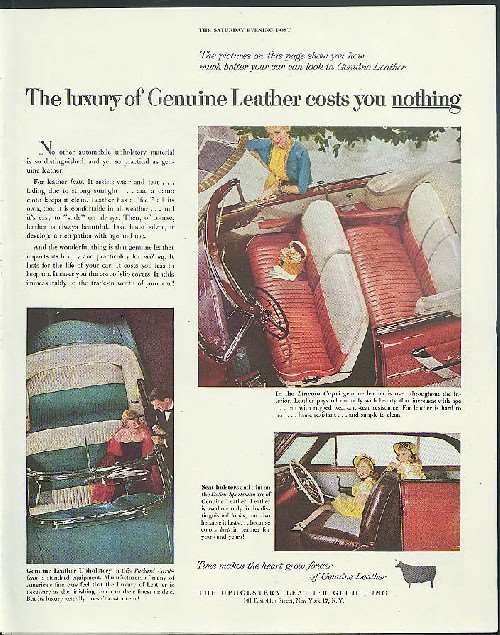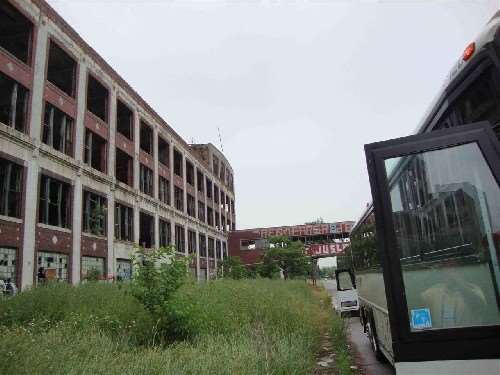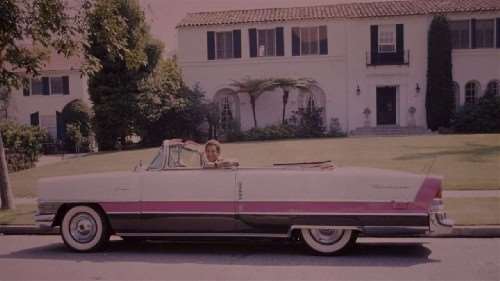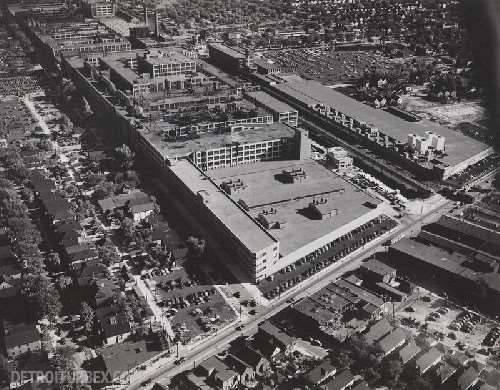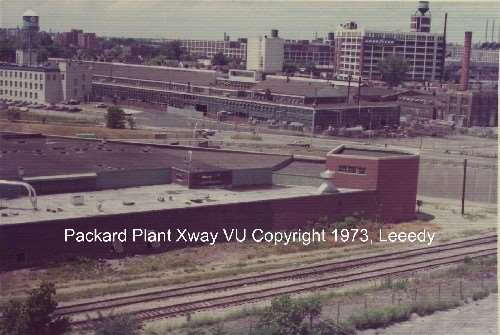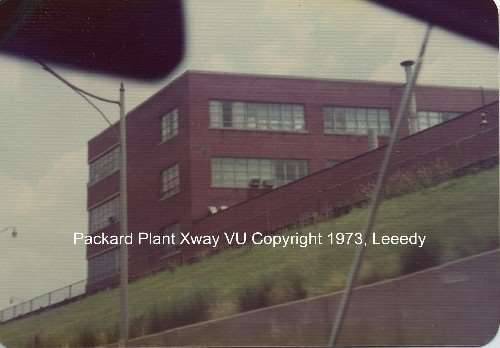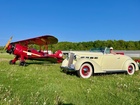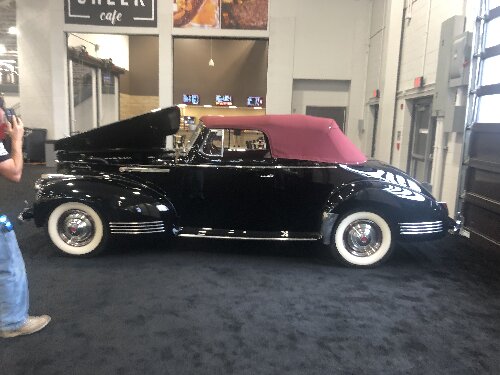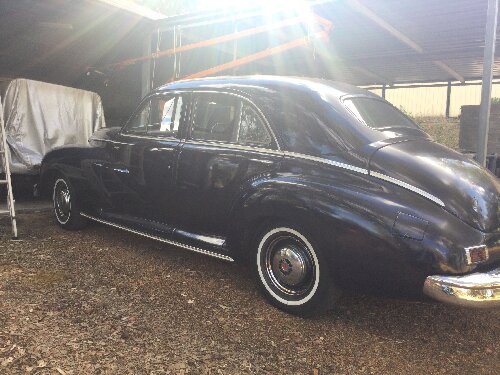|
Re: One Story Assembly Plant What If?
|
||||
|---|---|---|---|---|
|
Home away from home

|
Yes. Glad you enjoyed the tour. It was not planned for us to exit the busses and I was certainly reluctant to do so, but hey, it just kinda happened. I think for many people, they knew this might be their last-or only opportunity to see the original home of Packard this up close and personal.
By the way, the horrific jumble of weeds and crabgrass you see in this photo was once a beautiful lawn ringed by a low black iron barrier. At one point I remember for years they had platforms sitting here and new Packards would be posed on these platforms... displayed right here at the very space you see in my photo. Some people probably thought I had snapped my cap when I plunged into the weeds, but I was actually looking to see if any of the anchor points for the display stands were still in the ground. It is heartbreaking to see what has become of this very beautiful building and grounds. In the end, we were all safe and most everyone conducted themselves in a responsible manner. I don't think people realize this is a very dangerous area these days between the condition of the ruins and the crime in the area. Of course, what no one knew was that this very street was once bustling with cars and when I was growing up it was a major thoroughfare. I think I counted 2 cars driving past during the entire time we were stopped here-and this was a week day! Aside from seeing the devastation to the property the thing that had me choking to hold back tears was seeing NO traffic on this once-busy street. And seeing traffic lights either removed without even a stop sign... or the lights tied back and turned off. If my father were alive today, he would never believe such a sight. And the other thing I could never translate to you in words was the fact that I missed the wonderful smell that used to be here... metal, paint, rubber and oil... and the hum in the air. All gone now. I guess you just had to be there. I know it was a long time ago... but for me it still seems like yesterday...
Posted on: 2014/5/18 12:33
|
|||
|
||||
|
Re: TWIN 4BBL BATWING AIR CLEANER.
|
||||
|---|---|---|---|---|
|
Home away from home

|
The dual 4BBL "batwing" oil bath air cleaner for Chevy LOOKS the same, but the distance on the carbs is different. It will not fit. Once saw a Packard Caribbean unit butchered by a Chevy guy for sale at a SoCal swap meet in the 1970s. Guy couldn't figure out why it didn't fit his Chevy engine and was selling it claiming it had been "manufactured incorrectly by GM"...ahhh. Price was nice because of the seller not knowing what he had!
For a short time there was a MoPar version, but this had heavy ribs pressed into the top of the main section and would require some huge modifications to make it look and work right. It was painted gold. The Cadillac Eldorado batwing will fit on the Packard engine and carbs, but for a Packard must be turned backwards to the way it is used on the Cad. Also, the Cad has a cast chrome "V" symbol on top that would have to be removed and holes filled. Also, some of the Cadillac units attach their pots not using wing nuts, but rather with cast chrome dished knobs (these were actually old kitchen drawer pulls). It was also painted gold. And for the hanging "pots" on the batwing... the Chevy and early Eldo pots are the same as Packard. But Cadillac later enlarged their pots and those are much bigger than Packard. By the way... these pots are supposed to have oil in the bottom... to catch airborne debris. Thus the term, "oil bath"... And almost never does anyone use proper decals on this air cleaner in the proper positions. At one point, there was a large special decal that actually made it out onto a couple of these air cleaners for 1955, but apparently was not kept and was not on early production cars. There was none on the Howard Hughes/Jean Peters 1955 Caribbean which was a very early serial number car. I have indeed had batwings opened up and parts fabricated long years ago. But it is not an easy matter. There is tubing inside and of course, the main housings are die-pressed....AND have rolled flanges and stacks. A complicated assembly to duplicate accurately..
Posted on: 2014/5/18 12:00
|
|||
|
||||
|
Re: One Story Assembly Plant What If?
|
||||
|---|---|---|---|---|
|
Home away from home

|
Yes. I remember very vividly my dad owned commercial property on Mt. Elliot not far from the Packard Plant in the 1950s. Right next door to one of my dad's buildings was a construction company and my dad knew the owner. That man had friends in the building demolition biz.
One day we were having lunch around 1957-58 when the subject of the Packard Plant came up-as it often did back then. The construction company owner told my dad it would probably bankrupt any demo company brave enough to tackle the job. And when there was so much hassle and lost money tearing down the Hudson plant, no Detroit demo company wanted to touch the Packard plant back in those days. One more reason why and how it managed to hold on for so long. I firmly believe the plant would still be solid today had there not been silliness and fighting between the owner and City of Detroit or whomever else was involved. Just nuts. After all of that fighting... what taxes were collected? And what funds were lost permanently? And what happened to all of the poor businesses that were still in the plant and happy being there, paying rent? What happened to all of the money these businesses (and dare I say-JOBS) these small enterprises provided in this impoverished area? So instead, somebody, somewhere decided to have a ridiculous fight that resolved nothing... and to let this gigantic historic property be completely unguarded, trashed, and left open to every imaginable crime! Brilliant. And a crying shame. Anyway, I am well familiar with the goings-on at the Packard Plant on East Grand these days. I have friends in Michigan who occasionally spin past and take a look...even send newspaper clippings. Very sad. And yes, I already knew about scrappers stealing the roof reinforcement sections. Amazed at how they manage to get some of that metal out without killing themselves. But apparently it continues. And the question that nobody-but NOBODY-ever asks is... WHO are the companies buying all of this stolen material from the Packard Plant and other structures around Detroit and why are they not being held responsible? Like whatever scrap company that paid $75 to the retarded junkies who broke into one of my family's properties in Detroit and stole my two brand-new (NOS) Dodge Red-Ram hemi engines with GM 671 blowers stored since the 1950s (the engines went to my boat which was built in 1952). You think the company that bought these engines DIDN'T know they were hot? It's THAT crazy there. When the PAC National Meet took place in 2013 I conducted a bus tour that went to the ruins of the Packard Plant. I warned people to stay away from the walls of the building at Grand Blvd and Concord because I pointed out that the wall up near the roof was beginning to buckle. I knew that structural elements of the roof had been removed. I predicted it would not make it through winter and apparently I was right. No brick structure this tall and heavy can stand unreinforced-especially when it already shows signs of buckling. Below is a photo I took at that time that shows the bulge on the upper part of the wall above what was left of the Packard Bridge. No way that was going to last...
Posted on: 2014/5/18 10:55
|
|||
|
||||
|
Re: One Story Assembly Plant What If?
|
||||
|---|---|---|---|---|
|
Home away from home

|
Quote:
This will be my absolute, final comment on the rail/train situation at East Grand Blvd. and the Packard Plant there. I am only concerned about when the plant was in operation and nothing from today matters-be it GPS, Google maps, photos, 21st-century opinions or whatever. I grew up in Detroit and I saw brand new Packards being loaded on trains and trucks regularly. I am not guessing or opining about this. And there was never an issue getting raw goods in or cars out via train or truck. This is a fact. None of this hindered Packard-whether it "sucks" today or not. Most of the rail head and spurs that were in the loading area and storage lot were torn up and gone long, long, long ago. So it is senseless to argue over photos showing a decrepit line and the spur from the petroleum storage and coal storage today and attack that! And these two facilities don't even have one block of concrete, one brick or one girder left standing anyway. This is like looking at an ingrown toe nail on a corpse and pronouncing that this is the reason the person died! I also worked for several major car companies and there was no gargantuan rail yard to others either. Not at Hudson. Not at Mercury. Not at Dodge (which was HUGE as plants go). Not at De Soto... not at Cadillac...not at Ford Rouge... and heaven knows if anyplace deserved such a rail yard, they sure did! It was one of the few factories that literally took raw ore in one side and spit out finished automobiles on the other! There was a huge rail yard over in an area that served Chrysler and Plymouth... but it served numerous other factories too! Gargantuan rail yards would never have guaranteed success to an automobile company. RE: single-story plants... This is academic since (contrary to modern myth) Conner Avenue was not a single-story plant. And yes... it was indeed quickly torn down and made into a shopping mall anchored by Crowley's Department Store. I saw it happen. The thing that makes Grand Blvd. expensive to tear down is not merely that it is multi-story but the fact that it was built of poured, reinforced concrete-no matter how the cars inside were being built. Until more recent times when demo-by-implosion became popular on such structures they were nightmares to get rid of. It took an eternity to tear down the Hudson Plant in Detroit-which was also made similar to the Packard Plant. I know... I watched them from my family's store as day after day, month after month they swung wrecking balls at the thing and it did nothing but shake a little. Anyway, these are my absolute, final comments on the trains at Grand Blvd. and the construction of the plant... and the so-called "single-story" of the Conner Plant. So I will not be responding further on this...
Posted on: 2014/5/17 20:52
|
|||
|
||||
|
Re: One Story Assembly Plant What If?
|
||||
|---|---|---|---|---|
|
Home away from home

|
Quote:
Hello, No, it wasn't Palmer. But I vividly recall all of the trips we had to make to Belleville in the 1950s and it was quite a jaunt. I believe my grandmother knew some people named Palmer in the area, however. RE: Canton... Yes, I know exactly where it is and I have a cousin who lives there in a house he had built...also retired. RE: Willow Run... It was so far away from Detroit that when there were airplanes landing there and the talk was of making it into a new civilian airport, people could not wrap their minds around going that far away for a plane. The ground gap between Detroit City Airport over on the east side of Detroit and Willow Run in those days was considered gigantic. Thus evolved Detroit Metropolitan Airport which was much closer in, but still considered out in the sticks for those times. I am told that the Packard company plane was kept for a time at Willow Run, but I know it was also at Detroit City Airport for a long time.
Posted on: 2014/5/17 20:12
|
|||
|
||||
|
Re: One Story Assembly Plant What If?
|
||||
|---|---|---|---|---|
|
Home away from home

|
RE: the so-called "Willow Run Expressway"... Yesssss, I know alllll about the WIllow Run Expressway.... and I believe the Davison Expressway in Highland Park predated it. Anyway, my grandmother owned much of the land around Belleville, Michigan. I very, very, very well remember driving out there back in those days. If you know where that is, I assure you it was a half-day trip out there from Detroit in the early 1950s. Whatever freeway, people may be imagining today was a short strip of double roads that bent and went for only a while and then hit traffic lights. Anyone thinking it was "a snap" to go from downtown Detroit to Ypsi... wow. I have no idea what roads they were using... but it was nothing like I-94 is today!
RE: Free Press articles about Frost & French... I didn't need to read the Free Press about goings on at Frost & French since I knew most of everyone there and I was a customer too (still have F&F license plate frames)! I was certainly living in Los Angeles at that time and I was a founding member of PACs Earle C. Anthony Region, so anything unusual happening at Frost & French would have been easily known. As far as a man wearing a chauffeur's uniform driving the Caribbean... strange story... unless it happened to be Jamie Kay who was Peter's nephew...he was the one who got the car out of the garage. And yes, I knew who shot the car for Motor Trend and I have original photo proofs and posters made up by Petersen Publishing personnel who gave them to me back then. Yesss, still have them. Yess, know all about the restrospect MT article. Still have that too. By the way, whoever wrote that article claimed the car had "air bags" for suspension...so don't be to bowled over by stuff that was published about it back then-most of it written by people who knew nothing about the real details of the car. And the car wash in question was the Sunset Car Wash...located on Sunset Blvd. in West Hollywood...a few blocks away from Petersen's headquarters in those days. I did freelance and contract work there (at Petersen). RE: The Studebaker archivist response... Of course he would say "who?"... you should have asked any SoCal PAC member and you could have had an immediate and accurate response! As I said earlier, a friend of mine bought the car from Hughes' people in Hollywood and he has had the car ever since. I wrote the history of this car and it was published in the PAC The Packard Cormorant magazine back in the 1970s. Believe you can still buy that back issue of the magazine by going to PAC's web site and requesting one Or look on the back inside cover of TPC and there is a listing of available back issues and how and where to order them. You can also find old issues on eBay. RE: Whereabouts of the Hughes/Peters Caribbean today... It is alive and very well in a glass enclosure at the Automotive Driving Museum in El Segundo, CA. Curator there is Earl Rubenstein.
Posted on: 2014/5/16 23:01
|
|||
|
||||
|
Re: One Story Assembly Plant What If?
|
||||
|---|---|---|---|---|
|
Home away from home

|
Quote:
RE: the shortened building... You are correct. They did cut the building back. I remember exactly when they did this. They used the same brick and shortened the building....keeping the same look. Stone Container Corp. eventually moved in this building. RE: the Caribbean... Actually if you are referring to the icon here, it was my 1956 in Dover White, Scottish Heather, Maltese Gray. However, I know and have driven the Howard Hughes/Jean Peters car. A friend of mine bought it from the Hughes people back in the 1970s. I also wrote its history back in the 1970s. It is in the White Jade, Rose Quartz, Gray Pearl color scheme. Some people call this "white, pink, black" but the bottom color is actually a very dark metallic gray that looks close to black on photos. Interesting too that Rose Quartz was only used on the stripe of the 1955 Caribbean. It was not normally available on any other Packard for 1955. By the way, according to what she told my friend, Miss Peters was not particularly fond of the color scheme... which was another reason the car was parked in the garage of the Hughes Beverly Hills residence... and never driven again until her nephew got it out in the 1970s when I first saw it! I recall it had about 600 miles on the odometer when I first saw the car. This photo is a bit faded after all these years, but here I am driving the car in Beverly Hills in the early 1970s. If you look closely at the 1956, I had wire wheels on it. The Hughes/Peters car was ordered with standard Packard wheel covers...
Posted on: 2014/5/16 18:10
|
|||
|
||||
|
Re: One Story Assembly Plant What If?
|
||||
|---|---|---|---|---|
|
Home away from home

|
Quote:
The photo displayed in this posting is looking southward, but there is no "freeway" shown (we called them "expressways" back then in Detroit) because this photo was taken long prior to the building of the expressway (freeway). The term, "freeway" by the way was borrowed and adopted later from Los Angeles. Detroit actually changed all of the names from "Expressway" to "Freeway"...heaven knows why. But they were originally called expressways. There is a famous photo of a late 1940s all over the internet with a Packard next to a sign that says "To Detroit via Expressway"... Anyway, when the Edsel Ford Expressway was built it went right down Harper Avenue at this point, this Harper ceased to exist here. When the expressway was built, a concrete retaining wall was poured in at the very edge of Harper and all that was left of the long rectangular parking lot where you see cars sitting (blacktop lower center of the photo along the building) was a narrow access road. The expressway took every inch of land it could get. At one time prior to this, the Packard Plant property (and a small test track) extended north (lower right) of where Harper Avenue is in this photo. New car storage/shipping was off in the huge lot on the upper right of this photo-even after the Conner plant was put in operation. I am attaching two photos I took in 1973. One shows a view looking northward toward the Ford Expressway and what was left of Harper Avenue. I took this from the rooftop of the Packard Plant where I had access to go at the time. You can see two tracks were left at this time and you can see the bed where another was removed. If you look past the concrete ditch of a freeway (cars are down below) you can see Chrysler's Oilite Bearing facility, Good Year Tire & Rubber, and Mt. Elliot heading north toward Rinshed-Mason. Most of this stuff is gone now. At the time of this photo the north end of Packard along the expressway was occupied by Stone Container Corporation and Essex Wire Corporation. The other shot I took was while down below on the Edself Ford Expressway looking up at the concrete retaining wall and north end of the Packard plant as seen from the freeway. This is all you could see from the expressway because is is down in a narrow concrete ditch. In the B&W photo shown earlier in the post, I would be driving 30 feet below the surface of what was then Harper Avenue. Today this building is at Concord Avenue and the Edsel Ford Freeway. It is the end of same building you see in the lower end of the B&W photo in this posting. Also, today, all of the windows have sadly been bricked in. Probably why it has not been vandalized any worse than it has...
Posted on: 2014/5/16 15:04
|
|||
|
||||
|
Re: One Story Assembly Plant What If?
|
||||
|---|---|---|---|---|
|
Home away from home

|
Quote:
It is amazing, stunning that people are continuing to claim that the Packard plant had no rail access. This is simply just not true and I have been all over this topic in the posting section on this web site entitled "How did they do it?" Packard had tons of rail access. I was there. I saw it. Regularly. People are making all kinds of mistaken conclusions today off of bad photos and 21st century satellite views that leave off the reality of what things really looked like when Packard was in business! You may not be seeing it in photos and Google maps today, but it was certainly very much there! Rail heads came out of what was a huge shipping and storage lot at Mt. Elliot and East Grand Blvd. This had all been torn out by the 1960s, but sorry, it WAS indeed there when the plant was operating. There was a second line of track and spurs that went right through the plant and supplied coal to the power plant, oil, gasoline and lube to the plant depot and more. MORE rail access. It is neither fair, nor accurate to say that all this did not exist because it did! Most of this was removed in the ensuing years, but it certainly was there. RE: Conner Ave. Packard Plant being "single story"... Again, this is not true. There was indeed a second floor there and the first floor height was already huge. There were in fact overhead conveyors that indeed led to the second floor (as well as stairs) and you can see all of these things in plant layouts. And it is likewise amazing that people have somehow forgotten the total fascination in the 1950s with single-story facilities of all kinds... from schools to factories. Stacked floors, stairs and elevators were considered outmoded and old-fashioned in the 1950s. Every-and I mean every write-up about the Conner Avenue Packard Plant referred to it as "modern" and implied it was cutting edge in every way. Now, all these years later we have folks railing against single-story factories! RE: Packard Plant being "surrounded by urban residential"... (Presumably this means the Packard Plant on East Grand Blvd.) A good number of the people living in those "urban residential" areas in fact worked at the plant. And all of these areas came AFTER the plant, not before it. Furthermore, Conner had loads of residential area around it-which is why it was almost immediately turned into a shopping mall after Packard left! In fact, one of the most controversial government housing projects ever in Detroit was right across the street! I won't go into this one, but there were lots and lots of "urban residents" in the area... probably a lot more than over at Grand Blvd. Gotta know your Detroit history here. RE: buying Willow Run instead of Conner Briggs...Doing so would have been twice or even three times as expensive as doing Conner-if only from an operational standpoint. That would have been like going out of the world backwards. And Willow Run wayyyyy the heck out out by Ypsilanti in those days to a Detroiter was considered a HUGE trip... it was nowhere near Detroit city limits-no matter what direction it was on the compass. With Conner, the movement of cars by truck continued almost as it had earlier since the cars were still stored and shipped out from the same place as always at Mt. Elliot and East Grand Blvd. And the bodies had already been coming from Connor anyway. Had Packard moved to Willow run, this storing/shipping operation would have been lost too... or absurdly expensive to continue using. People today think nothing of going to Ypsi from Detroit. I have a cousin who lives there. But...this was a very, very long trip from Detroit (especially East Grand) out there in those days. And the highways were nothing like today when a drive to Ypsi is nothing. Again, gotta adjust your thinking from 21st century back to the 20th century and the 1950s. Furthermore, Packard bodies were already being built at Conner anyway! All Packard did was move the rest of the assembly line from Grand Blvd. to Conner to finish the complete car rather than truck the bodies from Conner over to East Grand. They didn't have to pick up every last thing and drag it over to Conner. So all of the howling about Conner is not about a complete move of anything. Yes, Conner could have been bigger. Yes, the move could have been a better one. Yes, the changeover could have been better refined. Much new equipment was added at the time and there were many unproven machines and processes that needed to have the bugs worked out. There just wasn't time to do all this. Then factor in the new V8 engine, new technology torsion suspension, new body styling... all these things were happening at the same time! It is a miracle that it worked out as well as it did with so many opportunities for something to go wrong! So people today need to put this all into perspective. RE: James Nance wanting to run Packard into the ground"... While this may be the opinion of those stalwarts (some of them good friends) who saw his moves as too brash, too naive, too radical or too expensive, the man did what he thought was best. But it was just too much, too late. Like the guy who yanked the helm on the Titanic hard to one side, there was no way that ship was not going to hit the iceburg. So if we want to do the blame-game here it was Curtiss-Wright that put the final nail in the coffin- no matter how many people were sticking pins in their Jim Nance dolls. Anyone who even remotely believes the fantasy that Jim Nance did NOT want Packard to succeed is simply mistaken. And obviously never talked with him. I can assure you, losing Packard broke Nance's heart and he was still hurting about it many years later-even if he rarely showed it. Of this, I can assure you... straight from the man.
Posted on: 2014/5/16 14:32
|
|||
|
||||

 (111.96 KB)
(111.96 KB)